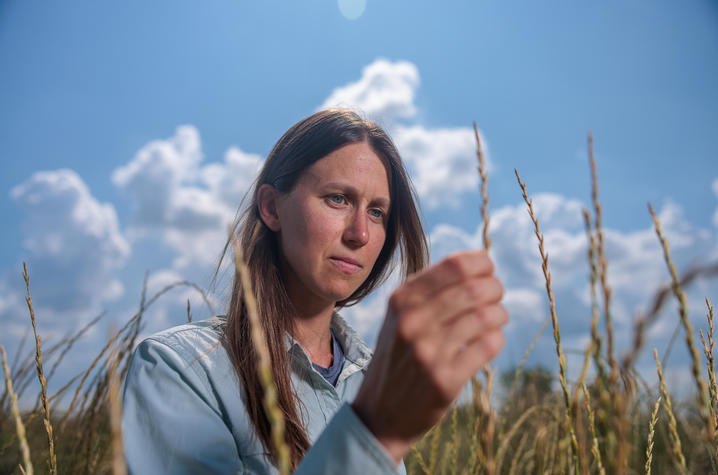Intermediate wheatgrass offers new option for Kentucky growers

LEXINGTON, Ky. (July 31, 2025) — A relatively unassuming plot of intermediate wheatgrass is turning heads at the University of Kentucky Martin-Gatton College of Agriculture, Food and Environment’s North Farm. Known by its trademarked grain name Kernza, the perennial cousin of wheat is the centerpiece of a three-year project aimed at preventing Kentucky’s hillsides from eroding while providing growers with a new crop to sell.
Plant geneticist Lauren Brzozowski, Ph.D., an assistant professor in the Department of Plant and Soil Science (PSS), is spearheading the trials. This work is supported by a $400,000 U.S. Department of Agriculture Southern Sustainable Agriculture Research and Education grant, enough to cover three field seasons, lab analyses and student help. Maker’s Mark provided additional support for this project.
Brzozowski’s group planted the first plots in Spring 2023 and a second wave that fall. In their second growth season, the plants were sufficiently dense and robust enough to remain established as a perennial species.
“Intermediate wheatgrass is native to Eastern Europe, but for the last two to three decades, it’s been selectively bred to work as a grain crop,” Brzozowski said. “The version we’re using is Kernza, which has been developed to reduce seed shattering, increase grain size and improve yield.”
The research spans several scales. At the North Farm research site, approximately 1,000 individually tagged plants form a breeding nursery, another 400 grow in the C. Oran Little Research Center in Versailles, with 200 more each in plots at the Robinson Center in Quicksand and the UK Research and Education Center in Princeton. The long-term goal is to develop a Kentucky-adapted variety that producers can drill once and harvest for both grain and forage over multiple years.
While Brzozowski tracks genetics, PSS associate professor Hanna Poffenbarger, Ph.D., tackles the management questions growers will ask first. Her team compares seeding rates, nitrogen programs and planting methods, measuring everything from stand density to grain weight.
“We need experiments like this so we can give growers solid recommendations,” Poffenbarger said. “Keeping roots in the ground year-round — deeper roots, bigger root systems and less disturbance — is good for soil organic matter and soil structure, and it helps reduce erosion.”
Preliminary observations look promising. The intermediate wheatgrass stifles weeds by its second year, and the grass can be mowed for hay before the grain heads ripen in midsummer. Poffenbarger called the dual use a perk for mixed crop-livestock farms, saying that “a producer could take an early forage cut, let the stand regrow and still run a combine in July.”
Flavor is another thread in the project. The team also turns Kernza flour into wheat doughs at 5% and 10% blends to judge taste and baking quality. Brzozowski says those trials matter because the grain is unlikely to push winter wheat off Kentucky farms.
“We don’t see Kernza replacing wheat,” she noted. “It complements wheat. Maybe it’s five or 10% of a flour blend, or an option on rolling ground where annual crops struggle.”
Brzozowski said the best-case scenario is that Kentucky growers adopt Kernza with clear management guidelines and sell the grain to local buyers, advancing sustainable agriculture across the state.
The team has already learned that a light nitrogen addition to a field split over two applications keeps plants vigorous. They have also documented how mowing after the first grain harvest suppresses summer weeds. Next up: sorting the strongest breeding lines and watching whether third-year yields hold steady.
“Every plot teaches us something,” Brzozowski said. “But the big picture is simple: Intermediate wheatgrass gives farmers a way to keep their soil, harvest a crop and do it again next year without replanting.”
This material is based upon work that is supported by the National Institute of Food and Agriculture, U.S. Department of Agriculture, under award number 20243864042988 through the Southern Sustainable Agriculture Research and Education program under subaward number 00003818. USDA is an equal opportunity employer and service provider. Any opinions, findings, conclusions, or recommendations expressed in this publication are those of the author(s) and do not necessarily reflect the view of the U.S. Department of Agriculture.
As the state’s flagship, land-grant institution, the University of Kentucky exists to advance the Commonwealth. We do that by preparing the next generation of leaders — placing students at the heart of everything we do — and transforming the lives of Kentuckians through education, research and creative work, service and health care. We pride ourselves on being a catalyst for breakthroughs and a force for healing, a place where ingenuity unfolds. It's all made possible by our people — visionaries, disruptors and pioneers — who make up 200 academic programs, a $476.5 million research and development enterprise and a world-class medical center, all on one campus.




